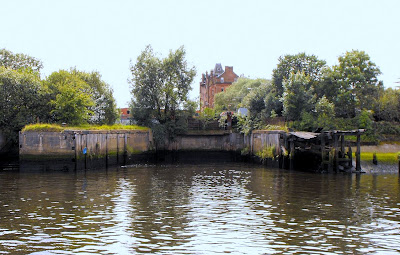My day today began with Ethel –May Abel, Ethel-May is ‘something’ that I have never met before – a ‘River Planner’. She has the enviable task of looking afrter the River Clyde in Glasgow’s City Planning system. Ethel-May also redefined ‘planner’ for me – she thinks of her role as being someone who ‘looks to the future’ often setting in train long-term strategy that may not seem immediately useful in the short-term.
 |
| Tram tracks in original cobbled road - Water Row |
There is an a view of the current downturn in development as a boomtime for long-term thinking – without developers queuing to buy any land that could contain a building – there is potential for the city to make land –swap deals to acquire bits of the ‘long-term jigsaw’ for the sustainable future of Glasgow. For Ethel-May this means fighting for the rights of things like public slipways, joining up areas of riverside walkway and protecting long buried pieces of river infrastructure from destruction by new underground pipes etc.
 |
| this is how the former Govan ferry slipway looks today |
Ethel- May looks at the city from the river and hopes for a return to the time when buildings were designed out from the river a time when streets were were things that happened behind buildings on the river. The Riverside Museum is an example of this current attitude, even though it is called Riverside the staff are trained to refer to the river frontage as the back of the building and the Tall Ship as being moored behind the building. The Govan Riverside housing that I am working with is certainly a case in point with most of the houses ‘turning their backs’ to the river – Davy Patterson (manager of Riverside Community Halls) told me that many of the residents “had not been down to the river in years” (even though none of the houses is more than 50 metres from the Clyde).
 | |
| New Museum to the right (with Glenlee in front of it) Govan Riverside housing to the far left |
 | ||
| Evidence that people at Riverside are beginning to 'face' the river again |
 |
| Strange angle onto looking over the Graving Docks to the Clyde....the new Museum appears to have crossed the river to amke a sandwich of the Glenlee with Govan as the other piece of bread |
Ethel-May was very supportive of the approach that we are taking at Riverside and made the amazing offer that local people could come up with an official name for the stretch of waterfront adjacent to the housing….currently this section of land has no name on maps etc. Today I became more convinced of a threefold strategy to support the Riverside community in asserting their public identity:
1. a programme of talks by experts in local history and culture at the Community Halls and a visit to the new Museum (before it officially opens) by a group of local people
2. a celebratory meal (with an ‘artistic slant’) to be held in the open air on the day of the public opening of the new Museum
3. using the events above as a means of arriving at a name for the riverside walkway adjacent to the housing (this name to be launched at the outdoor meal)
My next visit was to the inspirational Galgael project. I worked with the Galgael six years ago on the Kintra Street project (‘lead artist’ menu) – there primary focus is in supporting the overall health of their community by passing on practical skills to people and getting involved in projects that bring to the surface the latent culture and identity of Govan. In practical terms the Galgael are best known for supporting groups of local people to build traditional oak boats and then learning to sail them.
 |
| One of the early Galgael boats - in the workshop for repairs |
In addition they will get involved in anything they see as helping their community to help itself. Tam McGarvey updated me on current activity including a community garden in Elder Park, the Govan Folk University and their plan to erect a 16 foot granite obelisk opposite the Riverside Museum. Tam was enthusiastic about ways in which we could work together at Riverside and introduced me to Rosie who lives at Riverside and has volunteered at Galgael for 4 years.
 |
| The Galgael workshop |
Today, I also called in on a group of artists who work in part of a former shipyard adjacent to Riverside and met with Lesley McGregor who introduced me to more people from the Southside team at Glasgow Housing Association. I am beginning to understand at what ‘level’ I am interacting with the process of delivering ‘environmentals’ for Riverside……I am working with the people who shape the brief that is then handed down to ‘designers’. Until now I have asked to speak with ‘designers’ – as I am used to them being one of the key people that I ‘answer to’ when working on ideas for a place…..I keep being told that ‘designers are not part of the picture yet’ ….maybe this is really the holy grail of public art ‘being involved at an early stage’?! Thank you very much GHA and Peter McCaughey (no pressure then!).
 |
| Broomloan School has been derelict for years - I like the way the security grille makes space for the capitals of the stone columns |

